Pitch correcting vocals are common across a variety of genres, not only in recorded music but in live performances too. Although guitar effects pedals have been available for a long time now, it’s taken vocal pedals decades to catch up. With improved digital technology and processing, manufacturers have now produced some exceptional auto tune pedals for fine-tuning vocals.
Auto tune, like all effects, can be used in a variety of ways. Although it may have been unfairly labeled as simply a way to make a bad singer sing in tune, it far exceeds the limitations of that description. Auto tune pedals come with multiple processing options that can add stability to vocals, add a psychedelic layer to them, or subtly nudge the pitching back into tune if the singer strays slightly.
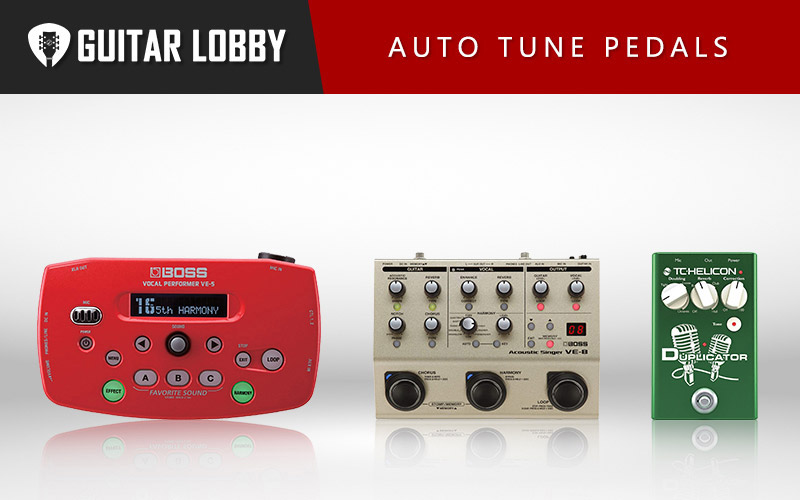
Whether you have any experience using auto tune in a studio environment or not, you’ll find it easy to produce good results using a pedal. Although auto tune VST plugins can become complex, the pedal incarnations are much more simplistic and do most of the work for you.
We’ll start this article by discussing the best auto tune pedals at each price point. For those of you who want to learn more about auto tune pedals before reading reviews, we have a buying guide at the bottom of the page.
| Name of Product | Image of Product | Description | Price Range | Full Review |
|---|---|---|---|---|
| 1. TC Helicon VoiceLive Play (Best Overall) | Type: Digital Effects: Autotune, Vocal Processing, | $250 | Read Full Review Below | |
| 2. TC Helicon VoiceTone C1 (Best Value) | Type: Digital Effects: Autotune, Vocal Processing | $140 | Read Full Review Below | |
| 3. TC Helicon Mic Mechanic 2 (Best Under $175) | Type: Analog Effects: Autotune, Vocal Processing | $150 | Read Full Review Below | |
| 4. TC Helicon Duplicator (Best Under $125) | Type: Digital Effects: Autotune, Vocal Processing | $120 | Read Full Review Below | |
| 5. Roland VT-4 | 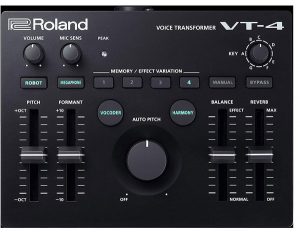 | Type: Digital Effects: Autotune, Vocal Processing | $260 | Read Full Review Below |
| 6. BOSS VE-8 | 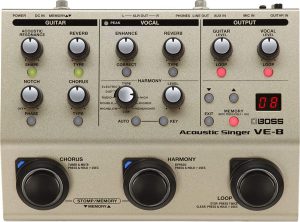 | Type: Digital Effects: Autotune, Vocal Processing | $300 | Read Full Review Below |
| 7. Zoom V3 | 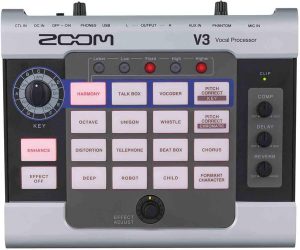 | Type: Digital Effects: Autotune, Vocal Processing | $200 | Read Full Review Below |
| 8. Joyo Vocal Lab R-16 | 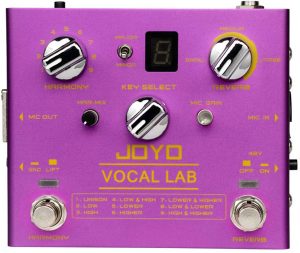 | Type: Digital Effects: Autotune, Vocal Processing | $150 | Read Full Review Below |
| 9. Boss VE-500 | 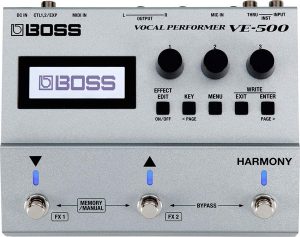 | Type: Digital Effects: Multi-FX | $140 | Read Full Review Below |
| 10. TC-Helicon Harmony G-XT | Type: Digital Effects: Autotune, Vocal Processing | $230 | Read Full Review Below | |
| 11. Zoom V6 | 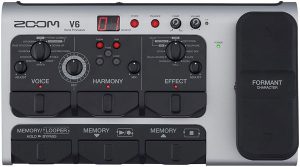 | Type: Digital Effects: Multi-FX | $350 | Read Full Review Below |
| 12. BOSS VE-20 | 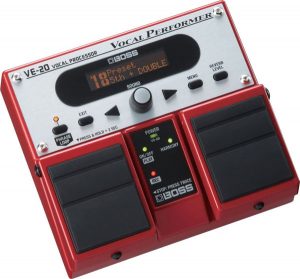 | Type: Digital Effects: Autotune, Vocal Processing, Octave | $270 | Read Full Review Below |
| 13. TC Helicon Perform V | Type: Digital Effects: Multi-FX | $360 | Read Full Review Below | |
| 14. BOSS VE-5 | 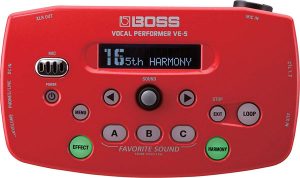 | Type: Digital Effects: Autotune, Vocal Processing, Multi-Effects | $290 | Read Full Review Below |
| 15. TC-Helicon TalkBox | Type: Digital Effects: Autotune, Vocal Processing, Synth | $130 | Read Full Review Below | |
| 16. TC Electronic VoiceLive Touch 2 | Type: Digital Effects: Autotune, Vocal Processing | $845 | Read Full Review Below | |
| 17. TC Helicon VoiceLive 3 | Type: Digital Effects: Autotune, Vocal Processing, Multi-Effects | $800 | Read Full Review Below |
Here Are The Best Auto Tune Pedals
1. TC Helicon VoiceLive Play (Best Overall)
![]()
| Estimated Price | $250 |
| Type | Digital |
| Effects | Autotune, Vocal Processing |
| Connectivity | 1 x XLR Input, 2 x Outputs |
| Power | 9 Volt |
My Review: The VoiceLive Play by vocal-effects experts TC Helicon sets the standard for auto tune pedals. It combines ease of use with a wide range of vocal processing options. Designed for simple real-time operation, this pedal can be controlled using the trio of footswitches or by using the hand-operated buttons which surround the LCD display screen.
Built into the VoiceLive play are over 200 presets inspired by popular songs or artist’s styles. These feature a range of auto tune effects that vary between extremely processed to subtle and understated. The presets can be toggled through using the up and down footswitches, or by using the rotary hand knob.
The LCD screen indicates the settings of each preset. You can use these presets as starting points and edit each of the effects: changing the characteristics of the auto tune, adding a variety of reverbs and delays, or distorting the vocals to your liking.
Another interesting capability of the VoiceLive Play is the harmonizer effect. This adds layers of notes to your existing vocal, and you can choose the intervals at which the notes play. When combined with the auto tune effect, you get a chorus of harmonies that resemble a vocoder. The pedal also has an auxiliary input for connecting an external sound source, a headphone output so that you can perfect the mixes with absolute precision.
In addition to the auto tune, reverb, delay, distortion, double-tracking, and modulation effects, there’s also a built-in looper. This is a highly useful feature for practicing harmonies or perfecting a vocal part when songwriting. The Auto Key detection feature is also worth noting, as this allows you to detect the key of a particular melody or song without requiring any prior music theory knowledge.
Who is This Best Suited for: The VoiceLive Play is the ultimate vocal processing station. It produces a range of auto tune effects, and additionally gives you access to a host of other vocal processing facilities. It’s the perfect choice for a singer who wants to add more than just auto tune to their set up.
Bottom Line: Despite its extensive range of presets, a wide array of built-in effects, and multiple connectivity options, the TC Helicon VoiceLive Play is surprisingly easy to operate. Using the footswitch controls, you can toggle through the settings, and edit them to suit your preferences. You can add delays, reverbs, distortion, and modulation to your vocals, detect the key of a piece of music or add harmonies to existing melodies all with this comprehensive pedal.
2. TC Helicon VoiceTone C1 (Best Value)
![]()
| Estimated Price | $140 |
| Type | Digital |
| Effects | Autotune, Vocal Processing |
| Connectivity | 2 x XLR Input, 1 x Output |
| Power | 9 Volts DC |
My Review: The TC Helicon VoiceTone C1 Hard tune pedal is the perfect solution for vocalists who want their performance to be polished and free from pitch-inconsistencies. If you need to create extreme hard tune effects, the addition of an on/off footswitch makes it possible to quickly bring the effect in or out of the mix.
The VoiceTone C1 can correct pitch with clarity and transparency. There’s a dedicated guitar input that can be used in conjunction with the pitch correcting feature, molding the tuning of your vocals with that of the guitar. This is very useful when improvising or jamming, as it allows you to sing melodies and the pedal tracks the key that your instrument is in and corrects the vocal pitch accordingly.
The quiet, high-quality preamp that is housed within the C1 ensures that the effects it produces are clean. The housing itself is made from die-cast metal, which is road-ready and able to withstand the rigors of touring. For added convenience, the manufacturer has installed a rubber slip-proof base, improving the stability of the pedal onstage.
The newly featured Mic Control circuit has also been built into the VoiceTone C1. This means that if you purchase the MP-75 microphone by the same manufacturer, you can control some of the settings of the pedal using the on/off switch on the mic. In fact, all VoiceTone pedals can be controlled using this method, removing the need to even be near the pedal onstage to operate it!
Who is This Best Suited for: Vocalists who require a mixture of pitch-correction and hard tuning will find the TC Helicon VoiceTone C1 to be a very valuable tool. It’s an easily operable pedal that doesn’t have an overwhelming number of controls and parameters, so if you like straightforward functionality, this is a recommendable pedal for you.
Bottom Line: The TC Helicon VoiceTone C1 is a multi-functioning auto tune pedal that features a range of subtle pitch correction presets, and more extreme, mechanical-sounding effects. It’s made solely for auto tune purposes, and so avoids the confusion of being littered with multiple processing options. Overall, this is easily one of the best auto tune pedals for the money.
3. TC Helicon Mic Mechanic 2 (Best Under $175)
![]()
| Estimated Price | $150 |
| Type | Analog |
| Effects | Autotune, Vocal Processing |
| Connectivity | 1x XLR Input, 1 x Output |
| Power | 9 Volts DC |
My Review: TC Helicon’s Mic Mechanic 2 is an affordable auto tune pedal that offers all of the most popular vocal processing effects in a compact housing. With a high-quality mic preamp, the pedal can add layers of effects to vocal tracks whilst preserving the natural tone of the singer’s voice.
The Mic Mechanic 2 requires 24-volt phantom power, which is produced internally and therefore doesn’t require an external connection to a mixer or interface. It can be powered either by a power supply or battery. With eight built-in presets and three main effects, the pedal can be used for numerous vocal-processing purposes.
The effects produced by this TC Helicon pedal include reverb, delay tone correction, and auto tune pitch correction. The delay channel is boosted by an automated compressor, EQ, and de-esser which all combine to ensure that the tone produced is as clean as possible. There’s also a Tap Tempo switch for syncing the delay with the BPM of a chosen song.
The auto tune feature of the Mic Mechanic 2 is easy to control. With a singular rotary knob that ranges from 0-100 in value, you can add more extreme amounts of hard tuning to your vocal tracks, or dial it in for more understated pitch correction. Combining the auto tune with the reverb and delay settings is a great way to soften the effect and make it less noticeable.
Who is This Best Suited for: If adding delays and reverbs to your vocals is important to you, then combining them with auto tune by purchasing the TC Helicon Mic Mechanic 2 is an option worthy of consideration.
Bottom Line: The TC-Helicon Mic Mechanic 2 is appropriately named – it takes care of the basic aspects of your vocal processing and keeps the sound tight and neat thanks to the built-in compression and filters. Although the auto tune control is adjusted using a singular knob, there’s still plenty of variety produced by the effect.
Popular Related Article: Our Favorite Vocal Harmonizer Pedals Right Now
4. TC Helicon Duplicator (Best Under $125)
![]()
| Estimated Price | $120 |
| Type | Digital |
| Effects | Autotune, Vocal Processing |
| Connectivity | 1 x XLR Input, 1 x Output |
| Power | 9 Volts DC |
My Review: If you haven’t noticed by now, there’s a clear leader in the field of auto tune pedals. TC-Helicon’s offerings combine value and reliable performance, with each pedal featuring slightly different capabilities to the next.
The Duplicator is unique in its ability to take your original vocal track, create a replica, and then add layers of effects to it. With EQ, compression, de-essing, and gate effects all housed within the pedal, there’s a variety of options available.
As far as auto tune is concerned, the pedal can be used in two ways. Firstly, you can simply set it to automatically correct your pitch chromatically, meaning every note you sing is identified by the pedal and nudged into the pitch of the nearest semi-tone. Alternatively, you can combine the auto tune with double-tracking or reverb, to create more far-out results.
The Duplicator pedal removes the need for adjustable gain control. To save you time and effort, the pedal automatically sets the gain of your mic, and in the process eliminates any feedback or electronic noise issues. Also, you can use the double-tracking effect to add octave layers, creating the illusion of multiple vocalists singing at once.
Who is This Best Suited for: TC-Helicon’s Duplicator is an ideal pedal for the vocalist’s who feel that their voice would benefit from the thickening process of double-tracking combined with a responsive auto tune.
Bottom Line: This pedal covers all of the basic requirements a vocalist needs to smoothen and add power to their singing. With automatic gain settings and chromatic pitch detection, the Duplicator pedal does most of the hard work for you.
5. Roland VT-4
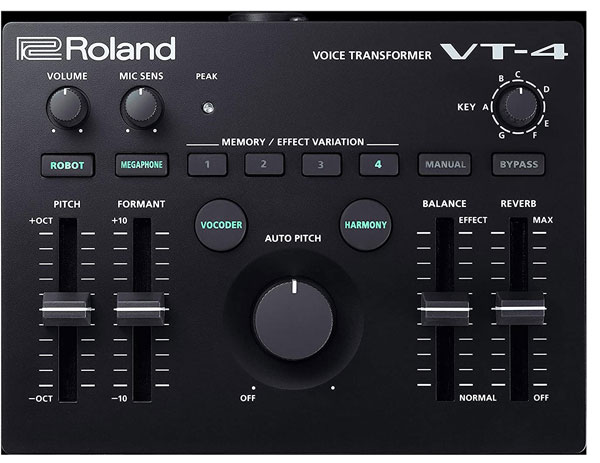
| Estimated Price | $260 |
| Type | Digital |
| Effects | Autotune, Vocal Processing |
| Connectivity | 2 x XLR Input, 2 x Output |
| Power | 9 Volts DC |
My Review: The VT-4 by Roland is an all-in-one vocal processing unit that resembles a turntable mixer in appearance. With a symmetrical dual-fader layout and a large Auto Pitch rotary control in the center, this pedal is both intuitive and detailed.
Included with the VT-4 is an array of vocal processing options. All of the controls are manual, with no screens or menus to toggle through, giving the pedal a vintage feel. The effects it produces blend modern processing with retro presets, covering everything from auto tune to slapback delay. You can even create authentic-sounding vocoder effects using the dedicated button.
Perhaps where the VT-4 excels the most is in its ability to deliver a smooth sounding pitch and formant alterations. Some auto tune pedals suffer from being tarnished by glitches and overly –computerized tones, but the VT-4 combats this by allowing you to control both the pitch and formant of your vocals using the dedicated sliders.
Another noteworthy attribute of this Roland auto tune pedal is its compatibility with MIDI. You can hook the pedal up to a MIDI keyboard and control the Auto Pitch, Harmony, or Vocoder engines using assigned keys of your choice. When using the vocoder, this is especially useful as you can trigger the chords that you want your vocals to match by playing them on the MIDI Keyboard.
Who is This Best Suited for: If you prefer manual, hands-on operation as opposed to menus and LCD screens, look no further than the Roland VT-4. Although it has a vintage look and feel, the pedal houses some modern and even futuristic-sounding effects.
Bottom Line: With a built-in vocoder, auto pitch correction, reverb, and delay units, the Roland VT-4 is a comprehensive processing unit. It has multiple connectivity options including MIDI and USB and is easy to operate thanks to the simple fader/rotary knob controls and selection switches.
Popular Related Article: The 14 Top Vocal Processors on the Market
6. BOSS VE-8
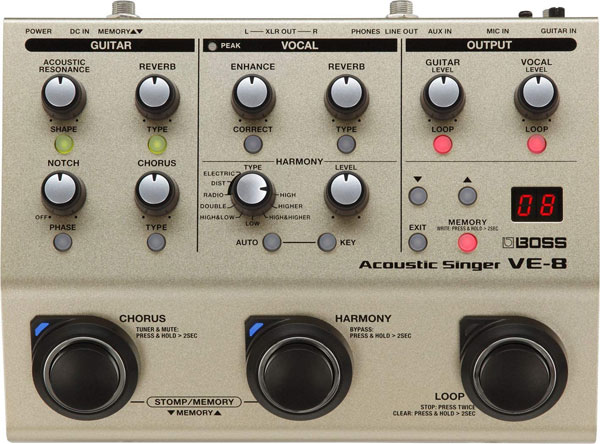
| Estimated Price | $300 |
| Type | Digital |
| Effects | Autotune, Vocal Processing |
| Connectivity | 1 x XLR Input, 2 x Output |
| Power | 9 Volts DC |
My Review: The BOSS VE-8 stands out amongst the crowd of auto tune pedals and vocal processors, with its specific focus on enhancing the performance of acoustic musicians. Robustly built and simple to operate, the VE-8 is home to a number of ambient vocal effects, pitch correction tools, and dynamic controllers.
The VE-8 also has the capacity to act as a looper pedal, so you can practice vocal melodies and harmonies without needing accompaniment. The integrated memory mode provides you with access to 50 slots where user-created presets can be stored and recalled at any time.
The auto tune feature can be used to iron out any inconsistencies in the pitch of your vocals, or alternatively as a hard tuning effect for more electronic purposes. When it is set the chromatic mode, the pedal simply guides your vocals towards the nearest interval in a natural way. You can also manually choose the key of your song and the pedal will respond in real-time.
Like most Boss pedals, the VE-8 is very easy to operate. Its layout is intuitive, and once you gain an understanding of the function of the various parameters, they become second nature. In terms of connectivity, the pedal can be integrated with stage monitors, and there’s a USB output for connecting to computers and loading in external presets.
Who is This Best Suited for: Acoustic singer-songwriters will love the Boss VE-8 auto tune pedal. With guitar and vocal processing options included, you can layer your output with an array of effects.
Bottom Line: The VE-8 offers vocalists a way to create and store their own unique presets using the multitude of onboard processing options. Auto tune, delays, reverbs, harmonizers and a loop station are all included in this extensive pedal.
7. Zoom V3
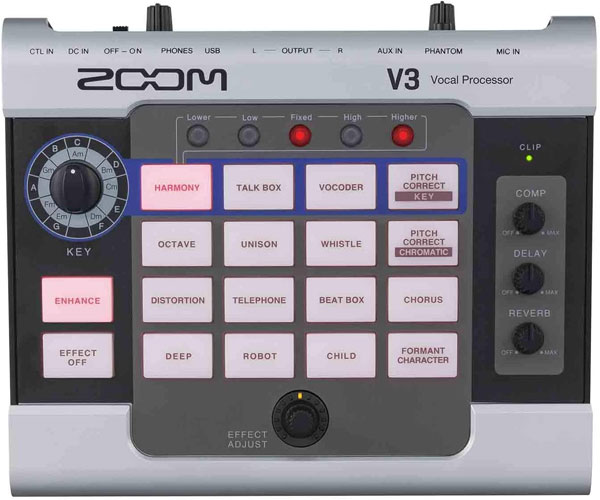
| Estimated Price | $200 |
| Type | Digital |
| Effects | Autotune, Vocal Processing |
| Connectivity | 1 x XLR Input, 2 x Output |
| Power | 9 Volts DC |
My Review: The V3 vocal processor by Zoom offers a range of auto tune tones alongside many other effects. The pedal can be used to create and arrange backing vocal accompaniments for your main vocals. Two additional voices can be added as layers to build interesting three-part harmonies ranging over a full octave.
This creativity-boosting auto tune pedal also houses a total of 16 vocal-based effects for further augmentation. You can add some grit to your vocals using the distortion channel, create psych-rock tones with the chorus effect, or add a futuristic touch using the onboard vocoder.
There’s also an interesting unison mode, which simply adds a double track to your vocals, and consequently makes them sound more stable and powerful. Layers of reverb and delay can be added to the output to soften the aforementioned effects. Then there’s the formant character button which adjusts the characteristics of your voice without affecting the pitch.
The connectivity options offered by the Zoom V3 are extensive. It doubles up as a fully-functioning audio interface when you connect it to a computer or laptop via USB. When used for this purpose, you can plug microphones directly into the pedal and use it to record audio into your preferred DAW.
Who is This Best Suited for: If you intend to purchase an audio interface at some point in the future, why not combine it with a vocal auto tune pedal by purchasing the Zoom V3?
Bottom Line: The Zoom V3 offers 16 idea-inspiring vocal effects that can all be adjusted to your liking. The pedal is multi-faceted, performing as a vocal processor or an audio interface for all of your recording needs. With multiple inputs and connectivity possibilities, it’s a worthy investment.
8. Joyo Vocal Lab R-16
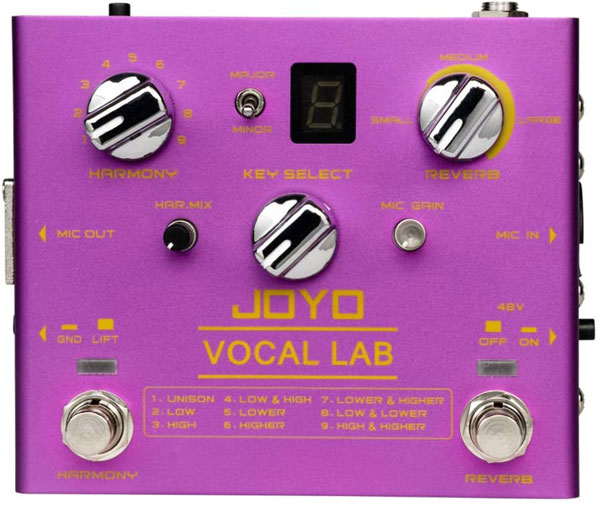
| Estimated Price | $150 |
| Type | Digital |
| Effects | Autotune, Vocal Processing |
| Connectivity | 1 x XLR Input, 1 x Output |
| Power | 9 Volts DC |
My Review: The Vocal Lab R-16 by ever-growing effects pedal manufacturers Joyo is an affordable hub for all your vocal processing needs. It offers a blend of effects, ranging from slight subtleties to in-your-face transformative varieties.
Housed in the Vocal Lab R-16 are a total of 9 vocal harmonies, 3 variations of spacey reverb, 12 assignable keys for the auto tune feature which span across major and minor selections, and a microphone gain control. The pedal produces 48-volt phantom power too and is therefore compatible with condenser microphones.
It’s easy to see when the gain starts to clip thanks to the visible LED indicator. You can toggle through the various reverb, harmony, and auto tuning options using the pair of footswitches situated at the bottom of the pedal. Additionally, there’s an auxiliary input so you can hook up your phone or other digital device using a 3.5mm jack and jam along to recordings.
Who is This Best Suited for: If you’re looking for a quality auto tune pedal at a fairly low-price, the Joyo Vocal Lab is worth considering. With a comprehensive set of vocal processing parameters, it covers all bases.
Bottom Line: The Vocal Lab R16 provides vocalists with a great way to add effects to their voice. The most impressive aspect of this pedal is its harmony-producing pedal. With 12 major and minor keys to choose from, you can activate the auto tuning and the pedal creates complex harmonies to accompany your main vocal.
9. Boss VE-500
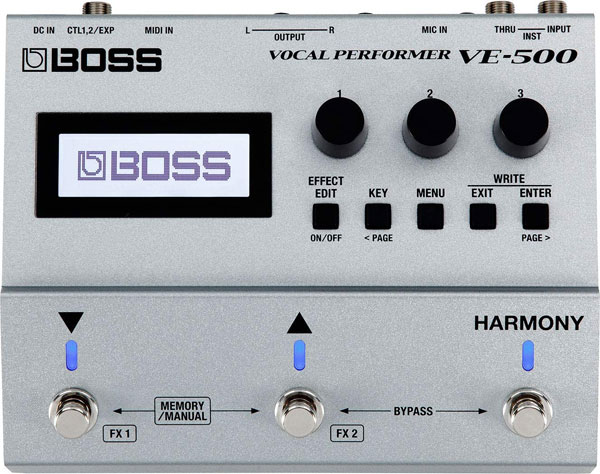
| Estimated Price | $440 |
| Type | Digital |
| Effects | Multi-FX |
| Connectivity | 1 x XLR Input, 2 x Output |
| Power | 9 Volts DC |
My Review: The Boss VE-500 Vocal Performer offers thousands of processing options and combinations, housed in a compact stompbox. It’s capable of running up to 9 effects at any one given time, so you can combine the plethora of delays, reverbs, distortion, compression, EQ, and auto tune to create unique vocal blends.
Granted, with such a powerful and detailed pedal, you’d expect the operation to be complex. However, the addition of three footswitches and a bright digital screen makes toggling through the settings a breeze. The onboard editing system can be used to add extreme modulation effects, making your vocals sound like they’re straight out of a sci-fi movie.
When it comes to auto tune, the VE-500 Vocal Performer is as good as any other pedal out there. With a dedicated pitch correction that can be guided by your guitar or MIDI keyboard, it’s easy to rectify any pitch inconsistencies within your performance. Two or three-part harmonies can also be generated using the key selector or chromatically.
Who is This Best Suited for: I’d strongly recommend the Boss VE-500 to all vocalists who would like to revolutionize their singing voice using multiple effects at once. It has a unique ability to combine processing options and the possibilities this pedal provides are almost endless.
Bottom Line: One of the most detailed, comprehensive auto tune pedals on the market, the BOSS VE-500 combines the simplicity we’ve come to expect from the manufacturer with a huge library of vocal effects. The auto tune, delay, reverb, distortion, or other effects can all be used simultaneously to completely transform your vocals. While this is not primarily a pitch correction pedal, but it can be used for that.
10. TC-Helicon Harmony G-XT
![]()
| Estimated Price | $230 |
| Type | Digital |
| Effects | Autotune, Vocal Processing |
| Connectivity | 2 x XLR Input, 2 x Output |
| Power | Volts DC |
My Review: TC-Helicon returns to our list of the best auto tune pedals, this time with the harmony-based G-XT. Borrowing the harmony and reverb technology from the revered VoiceLive 2, this pedal can be controlled by plugging your guitar into the pedal or simply as a standalone vocal processor.
The reverb algorithm produces a range of smooth spacey layers, which sound great when combined with the tuning and harmony effects of the G-XT. Choose from four double-track overdubs to add thickness to your vocals, or create experimental tones using the reworked FX presets.
Another brilliant aspect of this TC-Helicon auto tune pedal is the adaptive harmony gate. Located within the Tone section, this feature ensures that your mix remains as clean as possible even when the effects are present. The Harmony G-XT can be hooked up to a computer or laptop using the USB output, with many software updates regularly made available by the manufacturer.
Who is This Best Suited for: The TC-Helicon Harmony G-XT is well suited to vocalists who want quick access to harmonies and reverb. No music theory knowledge is required to operate the pedal thanks to its scale & key recognition.
Bottom Line: The G-XT is primarily a harmony pedal that crosses over into the worlds of reverb and auto tune. It features a newly reworked FX preset section that is filled with high quality reverbs, harmonies, and pitch correction capabilities.
11. Zoom V6
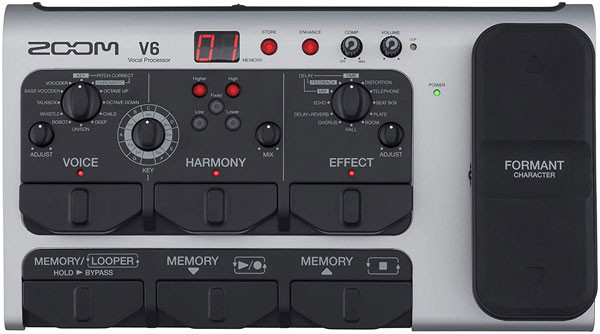
| Estimated Price | $350 |
| Type | Digital |
| Effects | Multi-FX |
| Connectivity | 2 x XLR Input, 2 x Output |
| Power | 9 Volts DC |
My Review: Zoom’s V6 vocal processor is a versatile piece of equipment that is sure to inspire vocalists to experiment with their sound. With several innovative features housed in an easily operable pedal, the V6 provides a great way to decorate one’s singing voice.
The processing of the V6 is of the level you’d expect to find in a recording studio on an effects rack – it is that good. It offers a selection of 12 different voice effects, including a vocoder, double-tracking, and auto tune-style pitch correction. Each of the effects can be adjusted using the onboard parameters, and stored in the user-preset memory bank, which holds up to 100 custom settings.
Another aspect of the Zoom V6 that makes it stand out against the competition is the built-in expression pedal. This uniquely controls the formant of your vocals, and when combined with the auto tune settings, can produce some exceptional results. There’s also a looper feature for creating vocal soundscapes.
Who is This Best Suited for: The Zoom V6 vocal processor pedal can do it all. If you desire to have all of the options present in the recording studio while playing live, then this multi-functioning auto tune pedal might be the ideal choice.
Bottom Line: With plenty of space for user-generated presets, high-quality effects channels, accurate pitch correction, and an expression pedal for adjusting formant, the Zoom V6 is a quite brilliant vocal processing hub. It can be used to produce mechanical sounding auto tune or vocoder effects or to simply add background harmonies bathed in reverb to your vocals.
12. BOSS VE-20
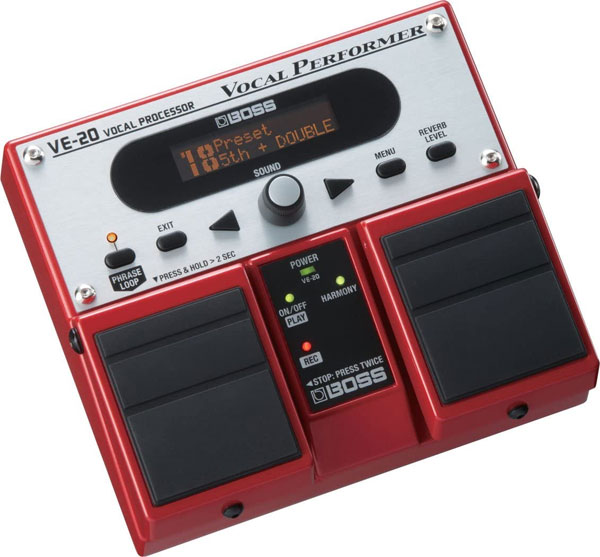
| Estimated Price | $270 |
| Type | Digital |
| Effects | Autotune, Vocal Processing, Octave |
| Connectivity | 2 x XLR Input, 2 x Output |
| Power | 9 Volts DC |
My Review: Another offering from effects-pedal legends Boss, the VE20 allows you to correct your pitch accurately in real-time. You can add intelligently generated harmonies to your main vocal, and even create loops or backing tracks to accompany yourself.
The pedal has built-in phantom power so it is compatible with condensers and dynamic microphones. It can be powered using a dedicated power supply or batteries, so there’s no danger of it suddenly cutting out on stage due to power issues.
Alongside the auto tune pitch correction, you also get access to the Special FX unit, which contains numerous distortion, radio, and strobe effects. These are pretty unique and uncommonly found on vocal processors. Finally, there’s the Phrase Looper, which offers 38 seconds of mono recording time and is very useful for composing vocal melodies or practicing harmonies.
Who is This Best Suited for: The VE-20 by Boss is well suited to vocalists who value simplicity. With the classic Boss looper design, you can control most of the pedal’s functions using the footswitches making for uncomplicated operation.
Bottom Line: Boss stompboxes are renowned for their durability and high-quality digital effects. The VE-20 reaffirms this notion and brings some unexpected features to your pedalboard. The Special FX unit is especially intriguing, offering megaphone vocal effects and many other unorthodox processing options.
13. TC Helicon Perform V
![]()
| Estimated Price | $360 |
| Type | Digital |
| Effects | Multi-FX |
| Connectivity | 1 x XLR Input, 2 x Output |
| Power | 9 Volts DC |
My Review: The Perform-V is a performance-enhancing auto tune pedal by vocal processing experts TC-Helicon. Designed to give your vocals a studio-like shine in a live setting, the pedal has a limited number of functions, with each one integral to its performance.
One way that the TC Helicon makes performing easier, is through its smartly designed snap-on attachment. Simply ease it onto the mic stand, and it will be suspended at the perfect height for operation while you are performing.
With very little in the way of unnecessary features, the Perform-V is refreshingly minimalistic. With that being said, it still offers plenty of sound-editing possibilities. You can adjust the EQ of your vocal output, add some compression, remove any unwanted plosives using the de-esser, or fine-tune the pitch of your vocals.
It’s also worth mentioning that the TC Helicon Perform-V can be connected to and operated by a smartphone. When combined with the free Perform-V app, the pedal excels. Using this app, you can load more presets onto the pedal, go deep into the individual characteristics of each effect, or load up backing tracks to jam along with.
Who is This Best Suited for: Singers who require many vocal processing options from their auto tune pedal without getting bogged down in overly complex operation are likely to enjoy using the Perform-V.
Bottom Line: Offering a range of delays, reverbs, compressors, EQ, auto tune, and pitch correction, the TC Helicon Perform V is a versatile vocal effects pedal. You can simply use the built-in presets or build your own by hooking the pedal up with the free app designed in conjunction with it. Although this pedal does have a hefty price tag, it’s one of the best auto tune pedals out there.
14. BOSS VE-5
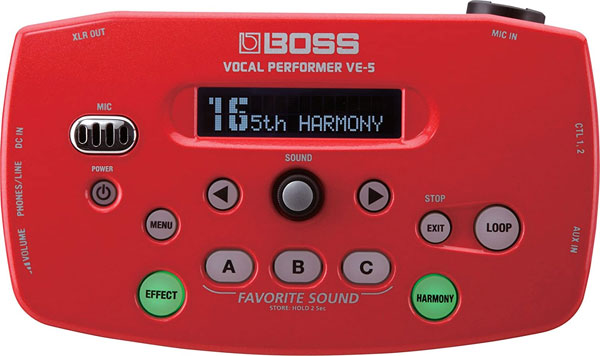
| Estimated Price | $290 |
| Type | Digital |
| Effects | Autotune, Vocal Processing, Multi-Effects |
| Connectivity | 1 x XLR Input, 2 x Output |
| Power | 9 Volts DC |
My Review: The VE-5 by Boss is a high-quality auto tune pedal and general multi-effects unit for vocalists. It provides simple and intuitive effects-generation options that require very little prior experience with vocal processing.
Featuring one-touch operation, the VE-5 houses six variations of top-end vocal effects that have been directly lifted from the popular VE-20 pedal. The effects included are delay, reverb, double-tracking, harmony generation, and a range of distortions.
The Phrase Looper feature is especially useful, allowing the singer to add interesting backing accompaniment to their vocals. You can use it to create beat-boxing loops or layer stacks of harmonies. There’s an aux input on the pedal for integrating external sound sources, and the internal microphone provides a quick way to record using the looper.
Who is This Best Suited for: I would recommend the Boss VE-5 to vocalists who want more than just auto tune from a pedal. With all of the main vocal effects included, this detailed stompbox acts a the central component of your live vocal rig.
Bottom Line: The Boss VE-5 is simple to operate, but deceptively detailed. With reverbs, delays, distortion, auto tune pitch correction, and looping capabilities, it’s a great tool for performing, practicing, and songwriting.
15. TC-Helicon TalkBox
![]()
| Estimated Price | $130 |
| Type | Digital |
| Effects | Autotune, Vocal Processing, Synth |
| Connectivity | 1 x XLR Input, 1 x Output |
| Power | 9 Volts DC |
My Review: TC-Helicon is back with a unique vocal processing pedal. The Talkbox offers premium synth tones along with a range of other processing options to take your vocals to the next level. It can be used to transform the nature of your singing voice or to tame the dynamics.
The vintage talkbox vocal effects are the standout features of the pedal. Ranging from muffled and distorted to robotic and futuristic, the talkbox generator responds to your vocals and colors them with unpredictable layers.
Featuring TC-Helicon’s revered Adaptive Tone programming, the Talkbox offers low-noise EQ, tight compression, accurate dee-essing, and gate control for ensuring that only the intended tones make it into your output. You can also use the pedal with an electric guitar if you feel like experimenting!
Who is This Best Suited for: The TC Helicon talkbox is suitable for vocalists who want their voice to be almost unrecognizable and draped in transformative effects. With a variety of classic effects combined with unique sounding talkbox presets, this pedal is not for the faint-hearted!
Bottom Line: Auto tune pedals all essentially do the same thing, but every once in a while you stumble across a unique offering like the TC Helicon talkbox. As the name suggests, its main focus is to produce talkbox-style vocals, but there’s much more to this pedal than that. With quality reverbs, delays, compressors, and EQ units, it’s an all-inclusive stompbox.
16. TC Electronic VoiceLive Touch 2
![]()
| Estimated Price | $845 |
| Type | Digital |
| Effects | Autotune, Vocal Processing |
| Connectivity | 2 x XLR Input, 2 x Output |
| Power | 9 Volts DC |
My Review: When you attach the VoiceLive Touch 2 to your mic stand, you are opening up a whole new world of vocal processing options for your live performances. This auto tune pedal has an extremely powerful internal processor that allows it to combine effects, store a large number of presets, and perform free of glitches.
With intelligent dynamic and tone-sculpting capabilities, the VoiceLive 2 is capable of much more than just auto tune or pitch correction. You can use it to alter the equalization of your vocals, compress them to limit the dynamic range, or create repeated sections using the looper.
The VoiceLive 2 contains hundreds of presets that are based on popular artists or songs. Once you find one that you like, you then have the option of customizing it by delving into the individual characteristics of the preset and adjusting the necessary parameters.
Who is This Best Suited for: The VoiceLive 2 is the only vocal processing pedal you’ll ever need. If you don’t mind spending a little extra than the average price of an auto tune pedal, I’d highly recommend considering this TC Helicon offering.
Bottom Line: With so many vocal processing options housed within the VoiceLive 2, calling it a pedal doesn’t seem like an adequate description. It acts more like a processing unit you’d find in a top-end recording studio, offering hundreds of tweakable processing options and high-quality auto tune presets.
17. TC Helicon VoiceLive 3
![]()
| Estimated Price | $800 |
| Type | Digital |
| Effects | Autotune, Vocal Processing, Multi-Effects |
| Connectivity | 2 x XLR Input, 2 x Output |
| Power | 9 Volts DC |
My Review: To conclude our list of the best pitch correction pedals and auto tune pedals available today, we have the exceptional VoiceLive 3, from, you guessed it, TC Helicon. Their flagship vocal processing pedal, the VoiceLive 3 offers every form of vocal effects you can think of.
The auto tune effect is highly versatile. With over 200 factory presets, you can look into the exact building blocks of each one to learn about how the sounds are produced, then implement this knowledge into building your unique settings.
The reverb and delays offered by the VoiceLive 3 are of the highest standard. There’s also the newly added talk box, chorus, bass, wah, and overdrive settings. You can even hook the pedal up to your guitar and set the hard tune or harmony generator to respond to the notes played on your instrument.
Who is This Best Suited for: The TC Helicon VoiceLive 3 may be one of the more expensive offerings on this list, but its quality is almost unrivaled. If you don’t mind splashing out in order to get the best quality possible, I highly recommend this detailed auto tune and vocal effects pedal.
Bottom Line: Comprehensive, fast, and intuitive, the TC Helicon VoiceLive 3 is an incredible vocal processor. With multiple auto tune presets that can be tailored to suit your desires, and an array of other high-quality effects, it’s the only vocal pedal you’ll ever need!
Choosing the Right Auto Tune Pedal (Buying Guide)
Auto tune has been around for decades in one form or another, but it’s only in the past 10-15 years that it has become an accessible effect that can be added to your pedalboard. Thanks to advancements in music technology, there are plenty of high-quality options out there for vocalists to choose from.
Although some music purists see auto tune as an easy fix for an incompetent singer, this is simply not the case. Granted, it has been used in recordings to trick the listener into thinking that some are a more talented vocalist than they are, but it has also been used to create some innovative vocal effects that convey true emotion and feeling.
In the remainder of this article, we’ll go over the individual aspects of auto tune pedals, and gain an understanding of how the effect works, how to get your desired results when using it, and how to combine it with other effects to enhance your vocal rig.
What is Auto Tune?
Although you may know it as the robotic, vocoder-like pitch-shifting effect that has plagued the music charts in recent years, auto-tune is used in a much wider sense than in that form. In reality, pretty much every recording you hear nowadays is likely to feature some form of pitch correction on the vocals. In the days before auto tune, artists would commonly use techniques like double tracking to iron out any flat or sharp notes, and one could think of auto tune as being an extension of the same desired effect.
Auto tune pedals are condensed versions of the original software, which make it possible for vocalists to correct their pitch in real-time when performing live. For energetic performers or those who sing challenging melodies, this is a true godsend. It removes the need to overly focus on pitch and creates a space in which the performer can truly perform with no self-consciousness concerning their vocals.
How Autotune Pedals Work
Autotune pedals work by allowing the singer to determine a reference point, which is usually a particular scale, key signature, or even a chosen group of notes. The pedal then tracks the input from the vocals, and when the pitch deviates from the notes in the chosen scale, it either flattens or sharpens them to bring them back into tune.
You might be thinking, how does the pedal know which note I am aiming for? Well, to answer this question it’s important to understand that auto tune pedals won’t make a terrible singer suddenly sound good.
You have to be in the ballpark for the pedal to correct your vocals. For example, if you set the reference key to A minor, and tried to sing the root note of A, but unintentionally sung an A sharp, the pedal would decide whether to flatten that note back to the intended A or push it up to the 2nd which in this case is the B. Depending on which note your effort came closest to, the pedal would make its choice.
Combining Auto Tune Pedals with Other Effects
Depending on the processing power of an auto tune pedal, it’s likely to house other vocal effects alongside pitch correction. Reverb, delay, distortion, and double-tracking are commonly featured on these pedals, and some offer the option of combining the auto tune with some of these effects.
The great thing about pitch correction is that it doesn’t alter the natural characteristics or tone of the vocals very much. Consequently, you can use it in conjunction with any other vocal effect and it will still perform to a high standard.
Many singers like to add a little dirt to their vocals to boost their presence and power. Alternatively, adding lots of distortion will produce a megaphone-like effect, which complements heavy auto tune very well.
The use of other effects with auto tune depends on the severity of the pitch correction you are using. If you are using auto tune to produce extreme, robotic tones that are being subjected to heavy pitch correction, then adding noticeable amounts of distortion, delay or reverb is likely to enhance this extreme sound.
If, on the other hand, you intend to use auto tune as a subtle way to improving the pitch of your vocals without anyone being able to notice that you are using it, then more gentle levels of other effects are probably a better option.
Auto Tune Pedals & Feedback
A common issue faced by singers when using vocal effects pedals is unwanted feedback. This is especially the case when the pedal produces gain-heavy effects like vocal distortion. Auto tune pedals are also prone to feedback, but some have internal circuitry that combats this.
It’s a good idea to add a feedback suppressor pedal to your vocal rig to avoid this problem from occurring. They are relatively inexpensive and work by tracking the signal for abnormal frequencies and removing them before they become present in the output.
Where to Position an Auto Tune Pedal in Your Signal Chain
Positioning vocal pedals is significantly different from positioning guitar effects pedals in your signal chain. A vocalist will rarely use more than one or two pedals, whereas a guitarist is likely to have many more.
Due to most auto tune pedals and other vocal processing pedals having many different effects built-in, it isn’t really necessary to have excess pedals when you can control the characteristics of your vocals through one central hub.
Auto Tune Pedals for Recording
Indeed, it’s more common for producers and musicians to use the VST plugins of autotune, Melodyne, or any other pitch-correcting effect in the recording studio than it is for auto tune pedals to be used. The main reason for this is because the software versions allow you to go deeper into the fine details of the vocals, editing singular notes, changing the formants, or extracting samples.
However, with live videos emerging as one of the most effect ways for artists to connect with their fans these days, auto tune pedals can be very useful in this environment. The pedal can be used to correct the pitch of vocals in real-time, therefore polishing the performance without needing to spend hours at the computer adjusting the vocals.
Due to there being many other effects commonly present on auto tune pedals, they’re also a good tool for setting up your preferred sounds and effects chains, then using the same settings whenever you record. This will save a lot of time in the long run and also allows you to develop a signature vocal sound that is used on all of your recordings.
You could experiment with the use of auto tune pedals and other instruments, not solely for vocals. I would always encourage experimentation, no matter how far-out one’s methods may be. Using a vocal auto tune pedal on guitar, for example, could create a completely unique tone that was waiting to be discovered by a musician who thinks outside of the box!
Choosing the Key
Advanced auto tune pedals will allow you to predetermine the key that a particular song is in, and the notes will be adjusted to match those found in that key. If you’re unfamiliar with how keys work, it’s worth researching the “circle of fifths” to gain a basic understanding.
Other autotune pedals may not provide you with the luxury of setting a key for each song, and they may simply pitch-correct the notes chromatically. Chromatic tuning is where the autotune pedal shifts the pitch of the vocals to the nearest note. This is a good option for accomplished singers, but if you tend to drift away from the intended note, it can drag your vocals further out of tune.
The most common scales that your song is likely to be in are the major and minor pentatonic scales. Although some of the time, the key of your song will be reflective of the first chord, this isn’t a reliable way to determine the key. The best way is to write down all of the chords you are playing, and check which keys they fall under.
Rate/Retune Speed
Although auto tune is used subtly in basically every musical genre in existence, it is best known for the robotic sound it produces when the rate parameter is turned up. Sometimes referred to as retune speed, this controls the amount of time it takes for the note to return to its natural pitch.
If you are an accurate singer and only require slight improvements to your pitch, it’s best to turn the rate/retune speed setting down quite low. This will produce a natural effect that is barely audible to the listener because it reduces the time taken for the autotune to correct the note before the next note comes in.
Conversely, if you want to create the classic Kanye West style auto tune that sounds artificial and mechanical, you can achieve this by cranking the rate/retune speed all the way up. This will cause the auto tune to bleed into the next notes, making the transitions sound wobbly, less smooth, and more unnatural.
Presets
One of the main features of advanced auto tune pedals is their ability to store user-created presets. A preset is essentially one or multiple settings that form a particular sound. These settings are then saved within the internal memory of the auto tune pedal and can be accessed instantly at a later time.
The capacity of auto tune pedals to store presets depends on the size of their memory, the number of slots allocated to user presets, and in some cases, whether the pedal has a connectivity option which allows you to tweak the settings through an app or software externally then upload the presets back onto the pedal.
In addition to having dedicated space for user presets, most auto tune pedals will already have presets built-in. In some cases, you can adjust the parameters of these presets and use them as the foundations to create your own unique settings. Alternatively, you might prefer to simply use the presets created by the manufacturer, which are often based on effects used in popular songs that feature auto tune.
The main advantage of creating and storing your auto tune presets within the pedal, is that you can instantly access them at any time. If the pedal has the capacity to store a large number of presets, you could use this feature to plan the vocal effects of a full live-set. Some auto tune pedals even allow you to name the settings, so in theory, you could create a different preset for every song that you play as part of your live show.
Generally, you’ll find that the more primitive auto tune pedals don’t have very much space for storing presets if any at all. On the more advanced offerings, it’s common to find that they can hold anywhere up to 200 user presets, especially if they are kitted out with a display screen and decent processing power.
Power Requirements
Auto Tune pedals generally run off 9 volts DC power. This can be provided using a dedicated power supply, or sometimes with a singular 9-volt battery. Some manufacturers recommend that you purchase their particular power supply, but this is optional, as all power supplies basically perform the same function and there are usually cheaper ones available.
The auto tune pedals that require more processing power and run more features may require 12 volts or even 18 volts of power. In this case, they should come with their power supply, as these are less easy for the customer to get hold of. Be sure to check the power requirements before firing up your new pedal for the first time.
Closing Thoughts
Auto tone pedals provide vocalists with a practical way to ensure that their live performances are of the highest standard possible. Although some see auto tune as an easy way out, I would argue that it’s just the same as any other effect – its purpose is to enhance your sound.

My name is Chris and I’ve had a passion for music and guitars for as long as I can remember. I started this website with some of my friends who are musicians, music teachers, gear heads, and music enthusiasts so we could provide high-quality guitar and music-related content.
I’ve been playing guitar since I was 13 years old and am an avid collector. Amps, pedals, guitars, bass, drums, microphones, studio, and recording gear, I love it all.
I was born and raised in Western Pennsylvania. My background is in Electrical Engineering, earning a Bachelor’s degree from Youngstown State University. With my engineering experience, I’ve developed as a designer of guitar amplifiers and effects. A true passion of mine, I’ve designed, built, and repaired a wide range of guitar amps and electronics. Here at the Guitar Lobby, our aim is to share our passion for Music and gear with the rest of the music community.
